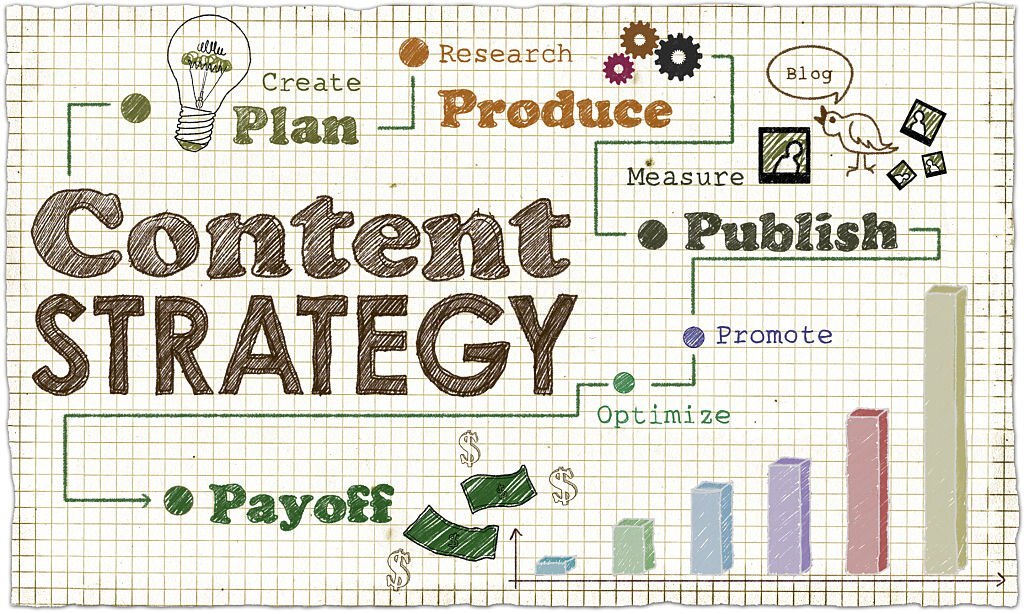Creating a successful content marketing plan is challenging. In recent times, growth marketing strategies have become extremely important for your online website. You must have a thorough understanding of your audience.
To drive traffic to your website, you must continually produce new material that others will want to share and link to. The length of the process is the sole drawback. And even if everything is done correctly, you cannot obtain the required traffic.
What if there was a method to bypass these issues and get the desired outcomes? Thankfully, there are various methods to accomplish it. This blog post will look at nine strategies you can adopt to improve your content marketing strategy. Let’s get started!
What is Content Strategy?
The continual process of turning corporate objectives and goals into a plan that employs content as the main tool for accomplishing those goals is known as content strategy.
Here is when the other aspects of content strategy begin.
Before you clearly understand what business objectives you can map content to, there is no need to discuss topics like a content audit, content governance, content plan, content creation, an editorial calendar, etc.
Knowing the bigger aims, you’re contributing to and why is your obligation as a content strategist.
Consistent results won’t be generated using the proper material for the wrong audience.
Content strategy is not a standalone concept. Building an editorial schedule, writing content, and releasing it is only a portion of the process.
Even if it has tons of fantastic stuff, it’s still not having a blog. It doesn’t include releasing sporadic content pieces in response to requests from the sales or product teams.
Your content strategy is not a strategy if it doesn’t begin with a commercial purpose. There is just content.
Why Use a Content Strategy For Growth Marketing?
There are several ways to enable “growth hacking,” even though creating a customized content marketing plan takes time. This term in marketing is very new but has recently gained a lot of popularity.
The most successful marketers that employ growth hacking techniques define the practice as adopting novel approaches to increase brand awareness, acquire new clients, and outperform the competition.
Growth hacking tactics aim to gain as many users or customers while spending as little money as possible. With these digital marketing techniques, you can gain more insight—and eventually, growth—from the material you create and distribute.
Here are 5 steps to enhance your growth marketing strategy
Step 1. Set Your Mission and Your Goals
Establishing a content marketing mission statement is an excellent start when developing your content strategy plan.
This brief statement makes it simpler to concentrate on what is crucial to include in your content and what is not so that your content marketing plan remains on course.
A mission statement for content marketing lists:
- Your intended market
- The material you’ll employ to contact them
- What they will gain
Your mission statement also helps define the kind of audience you are seeking. It emphasizes the advantage (insights on career development). Additionally, it provides instances of the topics it discusses (certification, digital transformation, skills development, and hiring practices).
While the mission statement outlines the benefits your content marketing plan will provide for your target audience, you should also consider the advantages it will provide for your company. Your business goals will then become relevant.
Majorly this includes:
- Increased revenue: If your content marketing strategy is effective, it will increase your revenue.
- Increasing sales: Meeting your income targets will be easier by increasing sales and obtaining more qualified prospects.
- Increasing traffic: Increasing website traffic is important since it increases the likelihood that your other objectives will be accomplished.
- Influence and authority: Enhancing the image of your company to increase influence, authority, and thought leadership.
- Optimized SEO: Success in SEO results in increased traffic.
- Reducing marketing costs: Reduced marketing expenses as the value of your content increases.
- Engagement with social media: Engagement on social media may boost traffic and authority.
Step 2. Establish Your KPIs
Setting defined, quantifiable objectives is the best approach to attain them. Establishing key performance indicators (KPIs) for your content marketing plan is necessary.
By offering milestone checkboxes, the KPIs will make it easier to determine whether your goals have been met. They will outline your goals for income, sales, traffic, SEO, traffic, and various digital marketing strategies, including email marketing and social media analytics.
Particular numerals will often identify these. You may wish to, for instance:
- Within the month, quarter, or year, reach a certain revenue goal.
- Increase the number of people who sign up for your lead magnet to indicate that you receive more high-quality leads.
- a certain quantity of new email subscribers
- Watch your website’s traffic and user interaction with its content rise.
- To increase traffic, raise some of your important pages’ search rankings.
- For your pillar content, achieve a predetermined quantity of mentions, shares, and comments.
- Receive an invitation to take part in some important business events
You should also keep an eye on your marketing expenses, measure the money you spend on various initiatives, and monitor how much it costs to generate leads and close sales.
Step 3. Know Your Audience
As was already discussed, to develop a successful content marketing strategy, you must thoroughly understand your target audience to provide the appropriate material for them. There are three things you must do.
Gather Demographic Information
The first step is to gather demographic information about your website visitors, email subscribers, and social media followers.
You can get the information you need about your audience through web analytics, web analytics, and email subscription analytics.
- Age
- Gender
- Education
- Income
You’ll learn more about their main areas of interest. Go to Audience » Interests » Overview in Google Analytics to discover this data. Your website visitors’ market segments will be visible to you.
Social media platforms provide comparable statistics. For instance, Facebook Page Insights allows you to obtain demographic data about your Facebook fans.
Get Customer Feedback
Try asking your present customers for comments to find out even more about your target market. You’ll get an understanding of:
- What do they think of the material you’re presently creating, and what are their top priorities are
- How can you solve their issues with your content?
- Receiving useful consumer feedback can assist you.
- Recognize the priorities of your readers and subscribers.
- Select the channels that will help you reach your consumers.
- Add details to your buyer personas
With the help of WPForms, you can quickly construct a survey to get consumer feedback.
With WPForms’ drag-and-drop builder, personalizing your survey is quite easy.
You may also benefit from additional potent features like smart survey fields, interactive survey reports, NPS polls, real-time polls, rapid notifications, and more.
Establish Buyer Personas
You may develop or add to buyer personas if you have demographic information and client input. Customer avatars sometimes referred to as buyer personas, are descriptions of your ideal readers and clients that help you better target your content.
The finest customer avatars contain details on your customers’ problems, difficulties, information sources, and behavioural drivers.
Knowing all of this will help you better understand:
- What sort of information your target audience will find engaging and useful?
- How does it benefit them?
- What will interest them about it?
Step 4. Create Content

As you can see, your content marketing strategy involves a lot of planning before you ever produce any content. But the moment has come to accomplish it. Although we’ll use a blog post as our example, these pointers may be applied to nearly any kind of content development.
You have already researched, so you know what kind of blog article to write. For instance, we know how-to articles and list postings are well-liked by our readers.
The moment has come to choose a title from the content calendar and get to work.
Research Your Content
When you’re prepared to write, you must ascertain:
- What is currently available
- How your fresh material may benefit your readers
This is conducting a Google search, looking at the most popular information on your subject, and determining how you might enhance it. This method is known as the skyscraper approach.
Original research is a viable choice if you’re gathering the correct kinds of information.
By conducting keyword research, identify the important phrases to employ for better SEO and higher search rankings.
Create the Content
Start writing or developing your content at this point. You must now consider how to convey your brand’s personality in the material you produce.
You could want to strike a balance between being professional and informal. Additionally, you’ll need to balance demonstrating your knowledge and condescending to your audience.
According to SerpIQ research, the material above 2,000 words has a significantly higher chance of appearing in the top 10 Google results. An article’s ranking seems to improve near the 25,00-word threshold. Pages in the tenth rank typically have 400 fewer words per page than pages in the first position.
Step 5. Figure Out the Best Content Channels
As you progress through this process, you’ll begin to understand where your audience hangs out and where you already have a strong online presence. Instead of attempting to achieve everything at once, it is wiser to concentrate on what is working and grow from there.
But you’ll need to check again at site analytics to be certain. Go to Acquisition » Social » Overview in Google Analytics to examine the primary social networks where your content is shared.
For instance, YouTube is where much of the social engagement is happening in our screenshot.
Enter your domain name into the onscreen search box when you visit their Content Analysis tool. Once you hit Enter, charts will appear that show:
- Network shares
- Shares by genre of content
- By content length, shares
- top articles from last year
For more specific results, you may also modify your search keywords.
With this knowledge, you can easily choose which networks to target to increase social media engagement and content sharing.
Types of Content For Growth Marketing
Including a variety of content marketing tactics in your approach is not necessarily required.
However, it undoubtedly affects your numbers.
This is so because the internet is constantly changing, and it might get boring to view the same stuff constantly.
The more money your company puts into varying your content, the better.
By doing so, you may examine the differences in each style and determine whether it is suitable for the kind of information you are attempting to convey.
Though there are various types of content marketing for growth marketing, in this blog post, we will talk about 6 such forms of content marketing.
1. Blog posts
A key component of content marketing is blogging. They raise consumer involvement and improve brand exposure.
When we examine how blogs operate, it becomes evident that they provide a platform that is so flexible that it can be used to post any type of information quickly and conveniently.
You can create a blog in a few minutes using tools like WordPress, which are ready to use right out of the box.
The effectiveness of this low-cost method of brand promotion depends only on the calibre of the material you provide.
A blog article is more likely to provide the outcomes you’re after if it’s extensive, thorough, and current.
2. Infographics
Many intricate concepts your company would wish to convey to its clients are just too difficult to do in a single blog article.
You sometimes require the accompanying images to adequately convey your answers.
This is where infographics are useful.
Infographics are visual representations of concepts. Typically, they emphasize bullet points and stats more than the lengthy text you would typically find in blog entries.
3. Videos
Who doesn’t enjoy seeing brief films with engaging subjects?
The internet has never been the same since broadband connections became more widely used and the YouTube age took off.
That’s because videos have become a dominant form of created material over the past few years.
Videos are challenging to make, but they deliver the best results.
After all, at least 100 minutes a day are spent watching videos, and 48% of consumers use videos to express their interests.
Today, if your business can produce quality video content, it will have a higher chance of converting and nurturing a lead than if it simply invests in written material.
4. eBooks
Another option for creating information for the internet is to publish eBooks.
They are longer documents that accomplish more than blog postings for a crucial factor.
Customers must give your business information about themselves, like an email address and a name, to download an eBook.
With that knowledge, your business can navigate the nurturing process and give customers more likely-to-engage content.
You should invest in this material since popular eBooks may greatly increase interest in the goods and services offered by your business.
5. Case studies
How about making sure prospective consumers stop by utilizing the knowledge your business currently possesses?
You may acquire stuff like that from case studies.
Case studies allow your firm to demonstrate how its expertise has benefited other companies while also allowing you to ensure that potential prospects fully get what you do and how you do it.
Case studies are a fantastic method to position yourself as a subject matter expert.
They are thus some of the best web content a business can create.
6. Checklists
Customers enjoy free tools, which is what you provide for them after creating a checklist.
This content marketing may ensure that your clients take the proper measures to accomplish their objectives.
They are excellent features to have on your website because of this.
Like an eBook, a checklist is quick and easy to create and may provide leads.
Content Calendar

You probably don’t need a content schedule if blogging is your pastime and you only post sometimes.
However, maintaining organization is essential if you’re utilizing content marketing to expand your internet business.
Three ways that content calendars can benefit your content marketing approach are listed below:
Firstly a content calendar ensures all your duties linked to content are carried out.
You’ll forget stuff if your schedule for producing material is chaotic.
- May write less frequently.
- Or fail to update previous articles.
- Or, to put it another way, a calendar ensures nothing gets missed.
Second, using a calendar facilitates team collaboration (and outside partners).
You might not require a content calendar if you run a one-person blog.
However, to ensure everyone is on the same page, you need to allow workers and contractors to contribute to your material.
Our content calendar today functions more like a project management tool than a calendar.
Thirdly, a content calendar provides a broad overview of your upcoming activities.
We utilize our schedule, for instance, to ensure that we don’t publish many case studies at once. Or two books that address the same subject. In this manner, we can view our full marketing plan for the upcoming several months on a single screen.
Optimal Practices
Yes, there are tools for creating content calendars. And I’ll discuss them more in this manual.
However, content calendars don’t have to be difficult to use. After all, their job is to make things easier for you and your team.
You may begin by creating a basic content calendar in Google Sheets. The following four things should be on every content calendar:
Editorial
Editorial is the most crucial component of your content calendar. These are the kind of material that you’ll be posting online, whether it’s on your blog, a podcast, or on social media.
Your content calendar’s main objective is to schedule your editorial material well. You can maintain organization and consistency with your publication schedule in this manner.
Some businesses have a whole year’s worth of editorial material planned out. Some independent bloggers might not be aware of their posts for the next week.
Platform
Your content calendar is hosted on the platform. Solo content producers have the most freedom when selecting a tool, from a simple spreadsheet to pen and paper to Google Calendar. That it functions for you is what matters most.
For content marketing teams, it’s a very different scenario.
A piece of material created by a team may be touched by 5, 10, or even 20 individuals before it is published. The status of each post must be visible to everyone, thus.
If not, you’ll receive a flood of emails from individuals inquiring about the status of this movie. or “Are the images for this Facebook post completed yet?”
And not just the content marketing and SEO teams may benefit from this type of information. Additionally, you may use it to distribute fresh content you’re working on to other team members.
Additionally, if you work for an agency or freelancer, you can link Basecamp, Asana, and Trello to your content calendar so your clients can see what you’re working on.
Promotional
Promotional is the second-most crucial component of your content schedule.
Promotional materials are exactly what they sound like: a means of disseminating your information.
When are you going to post it on Facebook? Do you have an upcoming Reddit AMA or podcast interview? Are you planning to send your email subscribers a newsletter? For your content schedule, such would be promotional activities.
The calendar for your promotional activities doesn’t have to be entirely distinct from the one for your editorial content.
However, it’s a good idea to give them distinct titles or colour codes so you can quickly distinguish between them.
Future Ideas
This is a list of potential article topics you have but aren’t currently working on. This may be an arbitrary subject that sprang to mind as you were driving to work, for instance. or a thought that surfaced during brainstorming.
Since they haven’t yet been planned, these ideas often don’t appear on the calendar.
Measuring Result
It’s now time to evaluate the performance of your content marketing plan. To do this, you will revisit the KPIs you established at the beginning of the content strategy plan to see what has changed and whether you are meeting your objectives.
For this, you may:
See how your material is performing. Check Google Analytics.
Google Alerts and Mention are additional resources for monitoring content marketing performance. You may check both of these to determine if your material is being shared and referenced, which will help you meet your awareness and engagement KPIs.
You may evaluate KPIs for the search rank of your content with the use of tools like SEMRush. Additionally, the statistics in your email marketing program will allow you to monitor email signups.
You can keep your content marketing plan current by adjusting it periodically as you go along by tracking your progress.
LSS: Your Content Marketing Partner
Creating and delivering content requires patience, effort and expertise. If you lag behind even in a single department, you risk falling behind your goals and competition. Thus, it makes sense if you want to focus on running your business and let experts do their job.
That’s where we come in.
We, at LeanSummits, are a full-fledged growth marketing agency. We help you develop and deliver highly customized, personalized content that is aligned with your consumers’ requirements. This is bound to accelerate your organization’s growth across a variety of channels, particularly those that matter most to your customers.
Schedule a free consultation to understand what an ideal content marketing plan looks like for your business.



